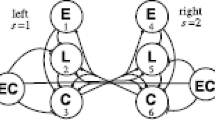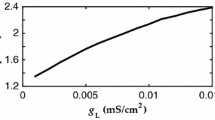Abstract
In the vertebrate spinal cord, a neural circuit called the central pattern generator produces the basic locomotory rhythm. Short and long distance intersegmental connections serve to maintain coordination along the length of the body. As a way of examining the influence of such connections, we consider a model of a chain of coupled phase oscillators in which one oscillator receives a periodic forcing stimulus. For a certain range of forcing frequencies, the chain will match the stimulus frequency, a phenomenon called entrainment. Motivated by recent experiments in lampreys, we derive analytical expressions for the range of forcing frequencies that entrain the chain, and how that range depends on the forcing location. For short intersegmental connections, in which an oscillator is connected only to its nearest neighbors, we describe two ways in which entrainment is lost: internally, in which oscillators within the chain no longer oscillate at the same frequency; and externally, in which the the chain no longer has the same frequency as the forcing. By analyzing chains in which every oscillator is connected to every other oscillator (i.e., all-to-all connections), we show that the presence of connections with lengths greater than one do not necessarily change the entrainment ranges based on the nearest–neighbor model. We derive a criterion for the ratio of connection strengths under which the connections of length greater than one do not change the entrainment ranges produced in the nearest–neighbor model, provided entrainment is lost externally. However, when this criterion holds, the range of entrained frequencies is a monotonic function of forcing location, unlike experimental results, in which entrainment ranges are larger near the middle of the chain than at the ends. Numerically, we show that similar non-monotonic entrainment ranges are possible if the ratio criterion does not hold, suggesting that in the lamprey central pattern generator, intersegmental connection strengths are not a simple function of the connection length.
Similar content being viewed by others
References
Andersson O, Grillner S (1983) Peripheral control of the cat’s step cycle. II. Entrainment of the central pattern generators for locomotion by sinusoidal hip movements during ’fictive locomotion’. Acta physiol Scand 118: 229–239
Ayali A, Fuchs E, Ben-Jacob E, Cohen AH (2007) The function of intersegmental connections in determining temporal characteristics of the spinal cord rhythmic output. Neuroscience 147(1): 236–246
Buchanan JT, Kasicki S (1999) Segmental distribution of common synaptic inputs to spinal motoneurons during fictive swimming in the lamprey. J Neurophysiol 82(3): 1156–1163
Cohen AH, Wallén P (1980) The neuronal correlate of locomotion in fish. ‘Fictive swimming’ induced in an in vitro preparation of the lamprey. Exp Brain Res 41: 11–18
Cohen AH, Holmes PJ, Rand RH (1982) The nature of the coupling between segmental oscillators of the lamprey spinal generator for locomotion: a mathematical model. J Math Biol 116: 3
Cohen AH, Ermentrout GB, Kiemel T, Kopell N, Sigvardt KA, Williams TL (1992) Modelling of intersegmental coordination in the lamprey central pattern generator for locomotion. Trends Neurosci 15: 434–438
Ekeberg Ö (1993) A combined neuronal and mechanical model of fish swimming. Biol Cybern 69: 363–374
Ekeberg Ö, Grillner S (1999) Simulations of neuromuscular control in lamprey swimming. Philos Trans R Soc Lond B 354(1385): 895–902
Ermentrout GB (1992) Stable periodic solutions to discrete and continuum arrays of weakly coupled nonlinear oscillators. SIAM J Appl Math 52(6): 1665–1687
Grillner S, McClellan A, Perret C (1981) Entrainment of the spinal pattern generators for swimming by mechanosensitive elements in the lamprey spinal cord in vitro. Brain Res 217: 380–386
Grillner S, Williams T, Lagerbäck PÅ (1984) The edge cell, a possible intraspinal mechanoreceptor. Science 223(4635): 500–503
Kiemel T, Gormley KM, Guan L, Williams TL, Cohen AH (2003) Estimating the strength and direction of functional coupling in the lamprey spinal cord. J Comput Neurosci 15: 233–245
Kopell N, Ermentrout GB (1988) Coupled oscillators and the design of central pattern generators. Math Biosci 90: 87–109
Kopell N, Ermentrout GB (1991) On chains of oscillators forced at one end. SIAM J Appl Math 51: 1397–1417
McClellan AD, Hagevik A (1999) Coordination of spinal locomotor activity in the lamprey: long-distance coupling of spinal oscillators. Exp Brain Res 126(1): 93–108
McClellan AD, Jang WC (1993) Mechanosensory inputs to the central pattern generators for locomotion in the lamprey spinal cord: Resetting, entrainment, and computer modeling. J Neurophysiol 70: 2442–2454
McClellan AD, Sigvardt KA (1988) Features of entrainment of spinal patern generators for locomotor activity in the lamprey. J Neurosci 8: 133–145
Miller WL, Sigvardt KA (2000) Extent and role of multisegmental coupling in the lamprey spinal locomotor pattern generator. J Neurophysiol 83: 465–476
Pearson KG (1995) Proprioceptive regulation of locomotion. Curr Opin Neurobiol 5(6): 786–791
Pearson KG, Ramirez JM (1990) Influence of input from the forewing stretch receptors on motoneurones in flying locusts. J Exp Biol 151(1): 317–340
Rovainen CM (1974) Synaptic interactions of identified nerve cells in the spinal cord of the sea lamprey. J Comp Neurol 154: 189–206
Rovainen CM (1985) Effects of groups of propriospinal interneurons on fictive swimming in the isolated spinal cord of the lamprey. J Neurophysiol 54: 959–977
Sakaguchi H, Shinomoto S, Kuramoto Y (1987) Local and global self-entrainments in oscillator lattices. Prog Theor Phys 77(5): 1005–1010
Tytell ED, Cohen AH (2008) Rostral versus caudal differences in mechanical entrainment of the lamprey central pattern generator for locomotion. J Neurophysiol 99(5): 2408–2419
Várkonyi PL, Kiemel T, Hoffman K, Cohen AH, Holmes P (2008) On the derivation and tuning of phase oscillator models for lamprey central pattern generators. J Comput Neurosci 25(2): 245–261
Williams TL, Sigvardt KA, Kopell N, Ermentrout GB, Remler MP (1990) Forcing of coupled nonlinear oscillators: Studies of intersegmental coordination in the lamprey locomotor central pattern generator. J Neurophysiol 64: 862–871
Yu XT, Friesen WO (2004) Entrainment of leech swimming activity by the ventral stretch receptor. J Comp Physiol A 190(11): 939–949
Author information
Authors and Affiliations
Corresponding author
Rights and permissions
About this article
Cite this article
Previte, J.P., Sheils, N., Hoffman, K.A. et al. Entrainment ranges of forced phase oscillators. J. Math. Biol. 62, 589–603 (2011). https://doi.org/10.1007/s00285-010-0348-6
Received:
Revised:
Published:
Issue Date:
DOI: https://doi.org/10.1007/s00285-010-0348-6




